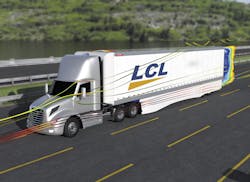The latest “confidence report” issued by the North American Council for Freight Efficiency (NACFE) released this week at the 2016 Advanced Clean Transportation (ACT) Expo in Long Beach, CA, determines that aerodynamic enhancements to Class 8 tractors can return a sizeable savings in fuel efficiency – even for day cab models, which many felt were incapable of benefiting from aerodynamics in the past.
“During the past 20 years, truck manufacturers have done a good job of improving the aerodynamics of sleeper tractors, saving up to 10% in fuel costs,” the group noted in its Tractor Aerodynamics report. “Tractor aerodynamic devices improve fuel efficiency by reducing drag so that it takes less fuel to move down the road, especially at higher speeds.”
Even though day-cab tractors operate at lower miles per hour, NACFE’s researchers found that they benefit from the installation of tractor aerodynamic devices.
“There is a long-standing misperception in the trucking industry that improved aerodynamics will only save fuel at speeds above 55 mph. Due to this, day cabs and other [tractor] duty cycles have lagged long-haul sleepers in their aerodynamic performance improvements,” the group noted.
“But in reality, aerodynamic drag is acting against the vehicle at all speeds above zero mph. Given the many low- or no-cost design elements that can reduce drag, even fleets operating at lower speeds should consider adoption,” NACFE noted.
At a press conference called to announce the new report at the Advanced Clean Technology (ACT) Expo in Long Beach, CA, NACFE executive director Mike Roeth called on truck manufacturers to make full aerodynamic packages like those offered on sleeper cabs also standard on their day cab tractors. Not only do those packages provide substantial fuel economy benefits even at lower speeds, but fleets tend to have much longer trade cycles for their day cab trucks, he pointed out. "The fuel savings over a decade [on a day cab] can also help fleets limit the risks of future diesel price increases," he said.
Some of the other findings from the group’s analysis include:
- If the aerodynamic features are removed from the OEM’s aerodynamic base model, a fleet can expect to lose about 10% in fuel economy.
- Another 10% can be lost simply by pairing a mid-roof tractor with a dry van or refrigerated trailer. Thus NACFE stressed that tractor and trailer heights should be matched for as many miles driven as possible as the fuel economy reduction from mismatched heights could exceed 10%.
- Even at today’s fuel prices of about $2 per gallon, a 10% savings in fuel represents $3,500 per year per truck.
- The greatest opportunity to benefit from aerodynamic tractor enhancements in terms of miles-driven and resultant fuel use remains on-highway van trailer segment – but for both day cabs and long-nose high-roof sleeper models.
- While the devices currently available on the market do add some weight to the vehicle, weight’s impact on fuel economy is just 0.5% to 0.6% per 1,000 lbs. of weight.
- There is less than a 2,000-lb. weight difference between the most aggressively optimized aerodynamic tractors and the least, so the maximum mile-per-gallon reduction due to the aerodynamics is less than 1.2% – far smaller than the potential fuel savings offered by aerodynamic enhancements.
- Many day cabs operate at highway speeds during nearly all of their duty cycle, so aerodynamic styling can increase fuel efficiency for day cab models by as much as 13%. Even day cabs operating in start-stop city driving will see savings from certain aerodynamic technologies, NACFE found.
- Yet aerodynamic systems have not been fully developed for all day-cab configurations yet, including ones operating on natural gas.
About the Author
Fleet Owner Staff
Our Editorial Team
Kevin Jones, Editorial Director, Commercial Vehicle Group
Cristina Commendatore, Executive Editor
Scott Achelpohl, Managing Editor
Josh Fisher, Senior Editor
Catharine Conway, Digital Editor
Eric Van Egeren, Art Director
